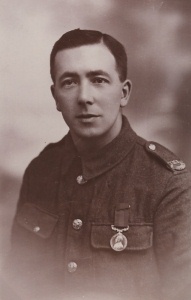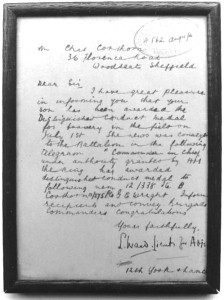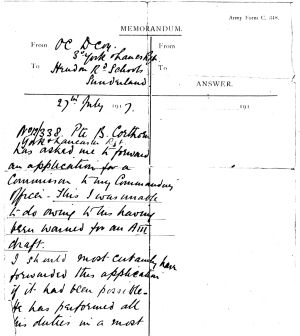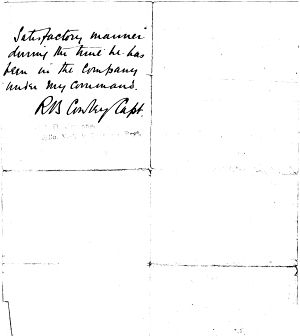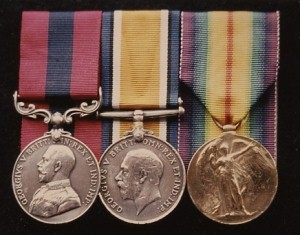
This article was written by John A. Mulholland and appeared in its original form in the journal of The Orders and Medals Research Society (Winter 1987). John has kindly allowed his excellent account of Bertram Corthorn's service with the Sheffield City Battalion to appear on this website. The day the Argentinians invaded the Falkland Islands I was visiting a friend in Sheffield. I noticed on the wall of his lounge a framed telegram dated 11 August 1916. It read: "I have great pleasure in informing you that your son has been awarded the Distinguished Conduct Medal for bravery in the field on July 1st . . ." The recipient of the D.C.M. was Pte. B. Corthorn of the Sheffield City Battalion (12th York and Lancaster). He was my friend's grandfather. Within a few minutes the medals had been brought down from the attic along with various letters, photographs and newspaper cuttings. With the help of these sources, some reference books and Corthorn's daughter and grandson I have put together Corthorn's story.
Bertram Corthorn was born on 19 December 1886 in Norton Woodseats to the south of Sheffield. He was the only child of Charles Thomas and Mary Jane Corthorn. The former was a tailor and the latter was the licensee of the White Hart hotel at Greenhill. In his youth Corthorn was an active member of Norton parish church. He was a member of the church choir and a regular member of the young men's bible class. On leaving school, Corthorn followed his father by entering the tailoring trade. He was twenty-seven years old at the outbreak of war in August 1914. In early September 1914 the Duke of Norfolk and Sir George Franklin visited the War Office and suggested the formation of a local battalion in Sheffield comprising of local men with a common connection. Permission was granted to form a battalion. Formal recruiting began on 10 September at the Corn Exchange in Sheffield. The placards read, "To Berlin-via Corn Exchange". Men volunteered in their hundreds over a two day period. Bertram Corthorn enlisted here on 11 September. Between 900 and 1000 men were enlisted and on 14 September they paraded for the first time. Their home was the Norfolk Barracks and their drill ground was Bramall Lane-Sheffield United F.C's famous home. During the first three months many men still lived at home and had no weapons or uniform. By 5 December the Battalion had moved to a camp at Redmires-high on the moors to the west of Sheffield. The first half of 1915 was spent in training, ending with a Civic Farewell at the Town Hall on 13 May. At the end of July Corthorn moved with the Battalion to Ripon camp for rifle training. By September the Battalion was in a new camp on the Salisbury Plain training for active service. The long awaited orders were received for overseas service. The Battalion embarked from Devonport on 21 December arriving in Alexandria on 1 January 1916-thus missing qualification for the 1914-15 Star by one day. Corthorn's Battalion worked on the defences of the Suez canal preparing a defensive position in case of a Turkish attack. The Battalion embarked from Port Said on 10 March arriving five days later in Marseilles. From there they travelled by train to Pont Remy, a few miles south east of Abbeville and marched to Bertrancourt arriving there on 29 March. Corthorn belonged to "B" Company which comprised of men mainly from the Penistone and Chesterfield districts. Between April and June his Company defended the front line at Colincamps; it was here they received their baptism of fire. During this period the Battalion sustained eighty-four casualties. On 8 April an enemy mortar bomb landed directly on "B" Company's post killing two and wounding seven. The Battalion had a difficult night on 15-16 May when the Germans opened up a heavy bombardment. This was followed by an attack by the Germans who entered the British trenches. The attack was repulsed and the Germans retreated. Most of June was spent in preparation and training for the Somme offensive. The role of the 31st Division was to form a defensive left flank for the remainder of the 4th Army which was to attack the German front-line system. In order to be in a position to form this flank, the Division had first to capture the fortified village of Serre, which was considered essential to the success of the general operation. The attack of the 31st Division against Serre was to be carried out by two infantry brigades-the 94th on the left and the 93rd on the right. The 94th Brigade had a frontage of 700 yards shared by Corthorn's 12th York and Lancaster on the left and the 11th East Lancashires on the right. Thus Corthorn's Battalion was at the extreme left of the 4th Army attacking on 1st July. Before 1 July the British opened up a heavy bombardment and made gas attacks in preparation for the offensive. At 7.00p.m. on 30 June, the Battalion set out from the rear to the front line trenches, opposite Serre, for the attack scheduled for 7.30a.m. the following day. The Battalion was due to arrive at their positions at 1.15a.m. on 1 July but owing to the bad conditions of the trenches they arrived at 3.45a.m. In the half light of dawn the Germans saw the troops assembling and at 4.05a.m. brought down a heavy bombardment on the British front line. Under these difficult conditions Corthorn and his Battalion had to wait over three hours before they attacked. The British artillery commenced a heavy bombardment on the Germans and under cover of this "A" and "C" companies proceeded into No Man's Land at 7.20a.m. and lay down about 100 yards in front of the British front line. (The British and German front lines were separated by approximately 200 yards in this sector). At 7.29a.m. the second wave climbed over the parapet and took up their positions about 30 yards behind the first wave. One minute later came zero hour, 7.30a.m. The whistles blew, signals were made in the din of the bombardment and the first and second waves moved forward to the attack. Corthorn was No. 1 Lewis gunner with the third wave which climbed over the parapet at this point. Waves of men moved forward at a quick step, in sections, across No Man's Land towards their objective. They met a hail of German machine gun fire and devastating shellfire.1 Musketier Karl Blenk was one of the Germans of the 169th Regiment facing the attack of the 94th Infantry Brigade. He wrote later: When the English started advancing we were very worried: they looked as though they must over-run our trenches. We were very surprised to see them walking, we had never seen that before: I could see them everywhere; there were hundreds. The officers were in front. I noticed one of them walking calmly, carrying a walking stick. When we started firing we just had to load and reload. They went down in their hundreds. You didn't have to aim, we just fired into them. If only they had run they would have overwhelmed us.2 The third wave, which included Corthorn, suffered heavily: by the time they had passed their own wire and had reached No Man's Land proper, they had lost half their strength. Captain Moore, "B" Company's commander, was soon hit but he saw Corthorn's six man Lewis team going into action. Three of the six men fell within 50 yards but Corthorn and the remaining two continued getting to within twenty yards of the German front line only to find the German wire was uncut by the bombardment. After ten minutes of fighting, the two other members of Corthorn's team were hit by snipers and machine gun fire, leaving Corthorn alone to work his Lewis gun. Corthorn dug himself into a shell hole with his entrenching tool and got his Lewis gun into action singlehandedly. He continued to sweep the enemy parapet, giving particular attention to an enemy machine gun until all his ammunition was expended. "I afterwards used the rifle which went red hot, then came the climax," he wrote home later, "it was found that we could get no further as we were right up against the German stronghold at the village of Serre."3 Finally Corthorn was hit by shrapnel in his right thigh. He crawled on his side to a nearby shell hole where he found one of his Lewis gun team, Pte. R. F. Brookes, who was badly wounded. It was an exacting position. They were receiving fire from the German front line-a mere 20 yards away. British shells were falling short of the German line and exploding nearby. It was 8.00a.m.-fourteen hours of daylight left and they were 180 yards from their own front line and safety. It was a long hot day. Corthorn and Brookes crouched in their crater. They could clearly hear the Germans talking to each other in their nearby front line. Brookes was in great pain from his wounds. Corthorn wrote later, "I could have got away on the Saturday night (1 July) but God forbid that I should leave a dying comrade . . . I made him as comfortable as possible in two cardigans and oil sheets and waited for the R.A.M.C. to come . . ."3 On that same Saturday night at the Battalion H.Q., the duty officer recorded the severe losses of the Sheffield City Battalion in the war diary: "Practically the whole Battalion has been wiped out. Clarke, Colley, Perkins, Carr are known to be dead. Beal is missing. The strength of the Battalion is now 4 officers and 19 men." Of the 651 officers and men who went into action, 266 officers and men were killed or died of wounds and 246 officers and men were wounded-a seventy nine percent casualty rate. As Sunday 2 July dawned it became apparent to Corthorn that the R.A.M.C. would not be coming so he decided to go for help that night. Another long day had to be endured in this uncomfortable position. Corthorn nursed Brookes in his arms through the day. Brookes died that afternoon after spending more than thirty hours together in the shell crater. At 10.30p.m. on the night of 2 July, after nearly forty hours in the shell crater, Corthorn began crawling across No Man's Land dragging his Lewis gun behind him. He carefully crawled through the knee high grass and past many corpses and safely reached the British front line. He reported to Brigade H.Q., delivered his Lewis gun and had his wound properly dressed. From here Corthorn was sent to the base hospital at Rouen and from there to Newport on the Isle of Wight. Within a few days he was transferred to a hospital in his native Sheffield. While recovering from his wound in hospital, Corthorn decided to hasten his planned marriage to Winifred Mary Woolhouse who lived in nearby Heeley. They got married by special licence on 9 August at St. Chad's Church, Woodseats. Three days later Corthorn's father received news from the adjutant of the Sheffield City Battalion that his son had been awarded the D.C.M. for gallantry on 1 July. Corthorn's company commander, Captain Moore, was by this time recovering from his wounds received on 1 July. On 19 August he wrote from a Manchester hospital congratulating Corthorn on the award of his D.C.M.: Dear Corthorn, Corthorn's award of the D.C.M. was unusual in that only three were awarded during the three and a half year existence of the Sheffield City Battalion. All three were awarded for the Battalion's attack on Serre on 1 July 1916. The other two awards to Pte. G. C. Wright (for services as a runner) and Pte. S. Matthews (for dressing the wounded under shellfire) were for services behind the lines. So Corthorn's D.C.M. is unique to the Battalion in that his was the only one awarded for "going over the top" and actually engaging the enemy. The D.C.M. was gazetted on 22 September 1916 as follows: For conspicuous gallantry and devotion to duty in attack. Being one of a machine gun team held up within 20 yards of the enemy trench, he succeeded, when all the rest of his team had been killed or wounded, in getting the gun to shell hole, and thence maintaining a heavy fire till all his ammunition was expended. While convalescing Corthorn visited the parents of Pte. Brookes who had died in his arms on 2 July. The parents, in gratitude, gave Corthorn a dinner service-the meat plate of which is still used each Christmas by Corthorn's family.
During the first half of 1917 Corthorn was attached to the 3rd Battalion, York and Lancaster Regiment, stationed at Sunderland. Among old letters there were several testimonials from a past employer, his vicar, and Captain Moore all supporting his application for a commission. All these letters were dated July 1917. However, a memo dated 27 July from his company commander advises Corthorn that he is unable to forward his application for a commission "owing to his having been warned for an AIII draft". It is uncertain which Battalion Corthorn was with when he was drafted back to France. But in October 1917 he was stationed in one of the many camps near Dickebusch about 5 km S.W. of Ypres. These camps were constantly subject to enemy shelling and aerial bombardment. During a raid on 15 October Corthorn was slow in getting into a ditch and he received a shrapnel wound in his left knee from a high explosive bomb. This wound was sufficient to send Corthorn back to England and he was subsequently discharged from the army as medically unfit for active service. He remained in England for the rest of the War and spent most of 1918 working in the docks in Liverpool. In the autumn of 1918 Corthorn's wife, who was expecting their first child, contracted influenza in the epidemic then sweeping the country and nearly died. After the war Corthorn was able to meet up with some of the survivors of the Sheffield City Battalion at a reunion dinner in Sheffield on 18 December 1920 when their old Corps Commander, Sir Aylmer Hunter Weston made a long speech reminding the survivors of those haunting days in July 1916. Corthorn and his wife returned to the tailoring trade in their own business. They had two children and continued in the business until 1930. Corthorn then went to work for Morrison's tailors in Norfolk Street, Sheffield, till 1951. From there he moved to the sawmakers Sanderson Brothers and Newbould and finally retired in 1958 aged 72.
Bertram Corthorn died at Walton Hospital, Chesterfield, on 20 September 1972 aged eighty-five. To the right of the Sheffield City Battalion on 1 July 1916 was the Leeds Pals (15th West Yorks). No doubt Corthorn's feelings were shared with Pte. A. V. Pearson of the Leeds Pals when he wrote: The memories of those heart-breaking days will last forever. The name Serre and the date 1st July is engraved deep in our hearts, along with the faces of our "Pals," a grand crowd of chaps. We were two years in the making and ten minutes in the destroying.2 © John A. Mulholland 1987 Acknowledgements Quotations from "The First Day of the Somme" by Martin Middlebrook reprinted by permission of Penguin Books Ltd. My thanks to the daughter and grandson of Bertram Corthorn for the use of letters, photographs and newspaper cuttings which were the main source of this article.
|
